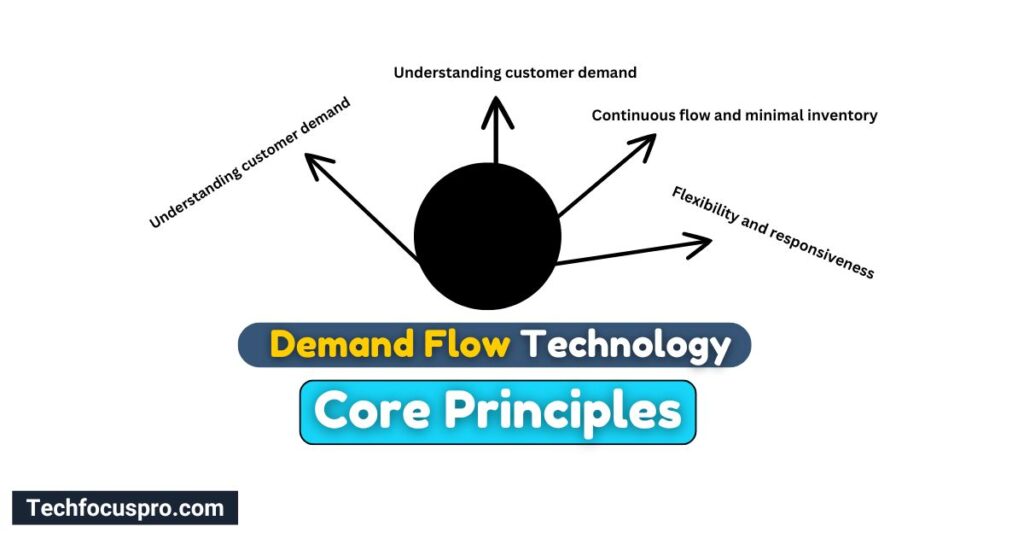What is Demand Flow Technology?

A manufacturing management strategy called Demand Flow Technology (DFT) aims to match production rates with consumer demand. Its main goal is to produce just what is required, when required, without causing delays or overproduction.
When manufacturers looked for more effective ways to adapt to changing market demands in the 1980s, DFT was created.
It was influenced by the ideas of lean manufacturing and has now developed to include real-time monitoring and sophisticated data analytics, which have increased its adaptability to shifting customer demands.
Importance of DFT in modern manufacturing:
Demand Flow Technology is essential in today’s cutthroat market because it helps businesses save waste, boost productivity, and enhance customer satisfaction.
Manufacturers can achieve improved resource management and cost savings by concentrating on demand. This ensures that they are producing the correct amount of product at the right time with the greatest quality.
What are the Core Principles of Demand Flow Technology?

Understanding customer demand:
Understanding client demand in great detail is the foundational tenet of Demand Flow Technology (DFT). This entails anticipating client needs and wants with precision.
Manufacturers employ various technologies and data analytic techniques to predict client wants. By analyzing demand, businesses can prevent producing too few or too many of their products.
Synchronizing production with demand:
This refers to lining up the manufacturing process to meet the market’s needs. By doing this, manufacturing rates are guaranteed to meet consumer demand. Businesses may prevent underproduction, which can result in lost sales opportunities, and overproduction, which can result in excess inventory and waste.
Continuous flow and minimal inventory:
DFT seeks to provide a constant flow in the production process. This indicates that goods pass through the manufacturing process without hiccups or delays.
Keeping your inventory to a minimum is critical because keeping excess product on hand can be expensive and ineffective. Having little inventory and a constant flow lowers storage costs and improves cash flow.
Flexibility and responsiveness:
Two essential components of DFT are responsiveness and flexibility. Flexibility is the ability to swiftly modify manufacturing procedures to satisfy shifting client demands. The ability of an organization to respond quickly to these changes is referred to as responsiveness.
By using DFT, manufacturers may become more flexible, quickly adjusting to market changes and guaranteeing customer satisfaction through on-time product delivery.
Components of Demand Flow Technology

Demand-Driven Production: Aligning output with real-time demand
Demand-driven production involves producing precisely what clients need when they need it. This method uses real-time data to determine the current level of client demand.
This helps firms cut waste and save money by preventing them from manufacturing too much or too little. When manufacturing is in line with actual demand, product availability is guaranteed, which raises customer satisfaction levels.
Flow Manufacturing: Streamlining processes to reduce waste
The goal of flow manufacturing is to provide a seamless, ongoing production process. This technique guarantees that products proceed swiftly through manufacturing by reducing disruptions and delays.
Simplifying their operations can reduce waste and inefficiencies, speed up production, and save expenses. The aim is a smooth transition from the beginning of manufacturing to the finished product.
Cellular Manufacturing: Organizing equipment and workers into efficient cells
Cellular Manufacturing entails dividing labor and equipment into small, pliable pieces known as cells. Because each cell is in charge of a distinct step in the production process, it is possible to expedite output and eliminate bottlenecks.
With this configuration, it’s simpler to monitor things and adapt as necessary. Cell-based production floor organization improves cooperation and efficiency, which boosts output.
Takt Time: Setting the pace of production to match demand
The rate at which a product must be manufactured to satisfy consumer demand is known as its takt time. It is computed by dividing the number of things buyers require by the available production time.
Establishing Takt Time facilitates efficient production schedule planning and management. By synchronizing production and demand, businesses can guarantee consistent goods and prevent shortages or delays.
Together, these elements provide a flexible and effective production system that closely satisfies consumer and industry demands.
Implementation of Demand Flow Technology

Steps to Implement DFT in a Manufacturing Setting
- Recognize Customer Demand: Start by studying your customers’ demands and trends in detail. Accurate forecasting is required to ensure that production meets market demands.
- Diagram Existing Procedures: Document the production operations currently in place to find inefficiencies and waste. This is a critical stage in determining areas that require improvement.
- Create the Future Situation: Create a more effective production method that complies with DFT principles based on the analysis. Think of ways to keep flexibility, maximize flow, and reduce waste.
- Employee Training: Inform employees about DFT principles and how they fit within the new procedure. Good training makes sure that everyone is committed to the change and on the same page.
- Execute in Stages: To test the new procedures, start with a single production cell or a pilot project. It is possible to make tweaks and adjustments while implementing gradually.
- Observe and Modify: Monitor performance constantly and adjust as needed. A system must be reviewed and improved regularly to be effective.
Tools and Techniques Used in DFT
- Kanban: Kanban cards are a visual scheduling system that helps manage inventory levels and workflow. They indicate when additional products or supplies are needed, guaranteeing a steady and uninterrupted flow of production.
- Pull Systems: Unlike projections, a pull system bases production on customer demand. This technique decreases overproduction, and things are only produced when necessary.
- Value Stream Mapping: This technique outlines each production stage to find and remove waste. It aids in planning a more efficient future state and visualizing the current situation.
Key Performance Indicators (KPIs) for Measuring Success
- Lead Time is the entire amount of time from the beginning of the production process to the product’s ultimate delivery. Shorter lead times signify a more effective system.
- Inventory Turnover: Calculates the frequency of sales and inventory replacements over time. Increased turnover rates are usually a sign of effective inventory control.
- Production Efficiency: The proportion of actual production output to what could be produced if all equipment was employed to its maximum potential. Improved resource utilization is indicated by higher efficiency.
- Customer satisfaction: Clients’ comments about the caliber of the goods and the timeliness of delivery. Elevated levels of satisfaction indicate that the DFT system is successfully fulfilling demand.
Together, these procedures, instruments, and KPIs produce a production process that is both responsive and effective, closely matching the expectations of the market and clients.
Benefits of Demand Flow Technology

For manufacturing operations, Demand Flow Technology (DFT) offers the following significant advantages:
- Increased Production Throughput and Efficiency: DFT facilitates process streamlining, which allows goods to pass through the production line swiftly and efficiently. This higher efficiency raises throughput, the measure of the total speed at which goods are produced.
- Shorter Lead Times and Better Delivery Results: DFT dramatically reduces the lead time interval between initiating the production process and handing the finished product to the customer. This enhancement guarantees speedier product delivery, improving customer satisfaction and delivery performance.
- Lower Inventory Levels and Related Costs: DFT minimizes the need to maintain sizable stockpiles of raw materials or completed goods by closely matching production to actual customer demand. As a result, there is less chance of having extra inventory, and storage expenses are reduced.
- Increased Flexibility to Respond to Market Changes: DFT enables producers to swiftly modify output in response to shifting consumer needs. Maintaining this adaptability is essential to the company’s ability to remain competitive and react quickly to changing market conditions or new client demands.
Impact of DFT on Businesses Across Various Sectors
Demand Flow Technology (DFT) has a significant effect on companies in a range of industries, including manufacturing and services. Cloudspace Technologies, a key player in this space, has demonstrated how businesses can achieve substantial benefits by carefully matching their manufacturing processes with actual customer demand and optimizing them.
The following are some significant effects:
- Enhanced Efficiency: Businesses can achieve shorter production cycles and more effective resource utilization by streamlining their processes with the aid of DFT. All industries benefit from this efficiency: manufacturing can produce goods more quickly, and service sectors can provide services more quickly.
- Decreased Costs: Businesses can save money by cutting waste and scheduling production to meet demand. Reduced inventory levels result in more money being recovered on unsold goods and storage expenses, which helps the company run more efficiently and profitably.
- Increased Customer Satisfaction: Thanks to shorter lead times and the flexibility to adjust to shifting demands, customers receive their goods or services promptly and dependably. Customers who are happy with a company are more likely to use it again and refer it to others, which boosts its position in the market.
- Operational Flexibility: Companies, as do markets, must be able to change with the times. DFT gives businesses the adaptability to change production levels and procedures in reaction to market changes, guaranteeing that they can successfully satisfy new client requests and stay competitive.
- Sustainability: DFT promotes more environmentally friendly corporate operations by cutting waste and improving resource usage. This not only lowers costs but also improves the environmental impact, which is becoming increasingly significant to customers and authorities.
To sum up, DFT can benefit companies in various industries by increasing productivity, cutting expenses, improving customer happiness, increasing operational flexibility, and promoting sustainability.
FAQs About Demand Flow Technology (DTF)
What is Demand Flow Technology (DFT)?
A production paradigm called Demand Flow Technology (DFT) aims to match actual customer demand with manufacturing processes. Its main goal is to establish a production environment that is responsive and effective, and that maximizes output while minimizing waste.
How does DFT increase productivity?
DFT increases efficiency by optimizing resource usage and production processes. It expedites production cycles and better uses labor and materials by removing waste and bottlenecks.
Can the service industries use DFT?
Yes, the service sector can also benefit from applying DFT concepts. By synchronizing service delivery procedures with customer requirements, service providers can optimize productivity, minimize wait times, and elevate client contentment.
Is DFT appropriate for all industrial processes?
Although DFT works quite well in many industrial environments, its applicability varies depending on the particular requirements and business environment. It works well in settings where manufacturing procedures can be tightly matched with customer needs and demand variability is controlled.
What are the main advantages of DFT implementation?
Enhanced production efficiency, shorter lead times, lower inventory levels and related costs, more adaptability to market fluctuations, and higher customer satisfaction are some of the main advantages of using DFT.
What role does DFT play in sustainability?
DFT promotes sustainability by reducing waste and maximizing resource use. This supports more environmentally friendly company practices by lowering manufacturing processes’ environmental effects and operating costs.
Conclusion
Demand Flow Technology (DFT) is an effective way to enhance production procedures. DFT assists companies in increasing productivity, cutting expenses, and improving customer happiness by concentrating on matching production to actual customer demand. It also gives you the freedom to quickly adjust to changes in the market and technological advancements, which helps you adopt more environmentally friendly practices.
In today’s dynamic economy, the DFT principles are still quite applicable. Manufacturers must remain flexible and adaptable as consumer needs change and technology develops.
As DFT embraces new technologies and combines them with other approaches, its future is bright.
Through integrating Industry 4.0, Six Sigma, and Lean principles, DFT is well-positioned to take the lead in developing intelligent and adaptable factory settings. DFT concepts will surely be vital in determining the direction of manufacturing in the future as companies continue to concentrate on sustainability, cost-effectiveness, and efficiency.







I was reading through some of your posts on this site and I conceive this site is very informative!